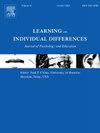Developmental trajectories of achievement goals and achievement in middle school students: Predictors and parallel processes
IF 3.8
1区 心理学
Q1 PSYCHOLOGY, EDUCATIONAL
引用次数: 0
Abstract
While much has been studied about the structure and correlates of students' achievement goals, their developmental trajectories are still largely unexplored. This study examines the developmental trajectories of achievement goals (i.e., task, self-enhancing, self-defeating, and avoidance) during middle school years, the relationship between these trajectories among each other and achievement, and the predictive role of gender, grade level, and grade retention. The participants were 1626 students from 5th and 7th grades followed over three years. Results from multivariate latent growth curve analyses showed an overall decrease in task, self-enhancing, and self-defeating goals, and an increase in avoidance goals. Changes in achievement goals were intertwined and related to academic achievement. Significant individual variation and stereotypical gender differences were also observed. Grade retention was associated with less steep variations in avoidance orientation and achievement. These findings reinforce the idea of a mismatch between the needs of adolescent students and the educational ethos.
Educational relevance statement
Understanding how students' achievement goals evolve over their middle school years and how these goals intersect with academic performance is pivotal for cultivating a learning environment that fosters academic success. Examining how these trajectories are predicted by individual variables, such as gender, grade level, and grade retention, offers valuable insights regarding on how these diverse pathways are shaped by students' unique characteristics and circumstances. Our research revealed an overall decline in motivation during the middle school years. Additionally, we observed unique variations in this trend among older students and those who had been retained, where the decline was less pronounced. These findings underscore critical aspects of achievement goals development, essential for helping educators tailor instructional approaches and provide appropriate support to students. Addressing these aspects can help bridge the gap between students' needs and what is offered by the educational context.
求助全文
约1分钟内获得全文
求助全文
来源期刊

Learning and Individual Differences
PSYCHOLOGY, EDUCATIONAL-
CiteScore
6.60
自引率
2.80%
发文量
86
期刊介绍:
Learning and Individual Differences is a research journal devoted to publishing articles of individual differences as they relate to learning within an educational context. The Journal focuses on original empirical studies of high theoretical and methodological rigor that that make a substantial scientific contribution. Learning and Individual Differences publishes original research. Manuscripts should be no longer than 7500 words of primary text (not including tables, figures, references).
 求助内容:
求助内容: 应助结果提醒方式:
应助结果提醒方式:


